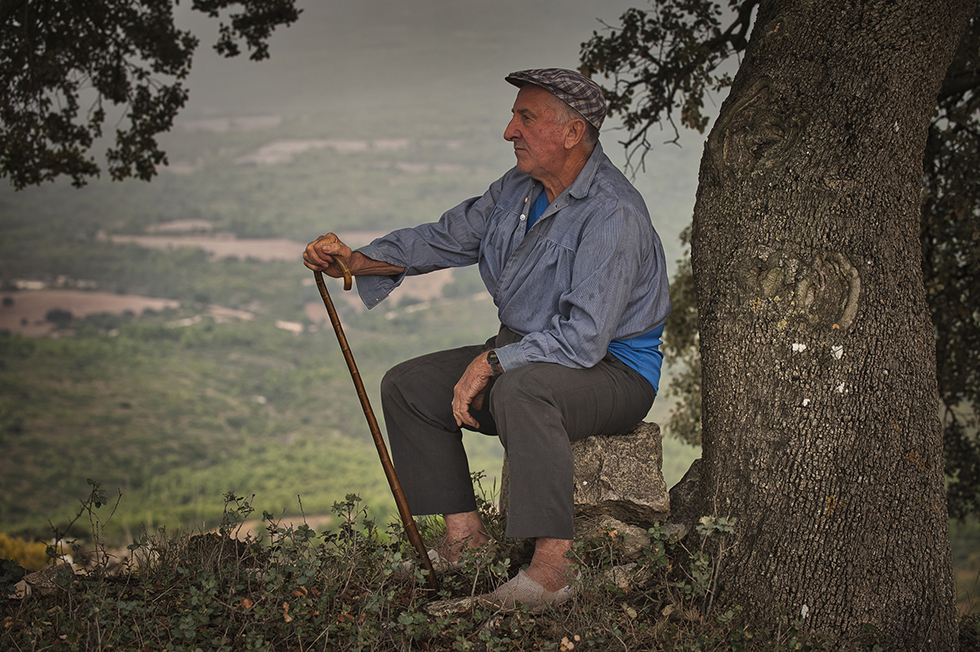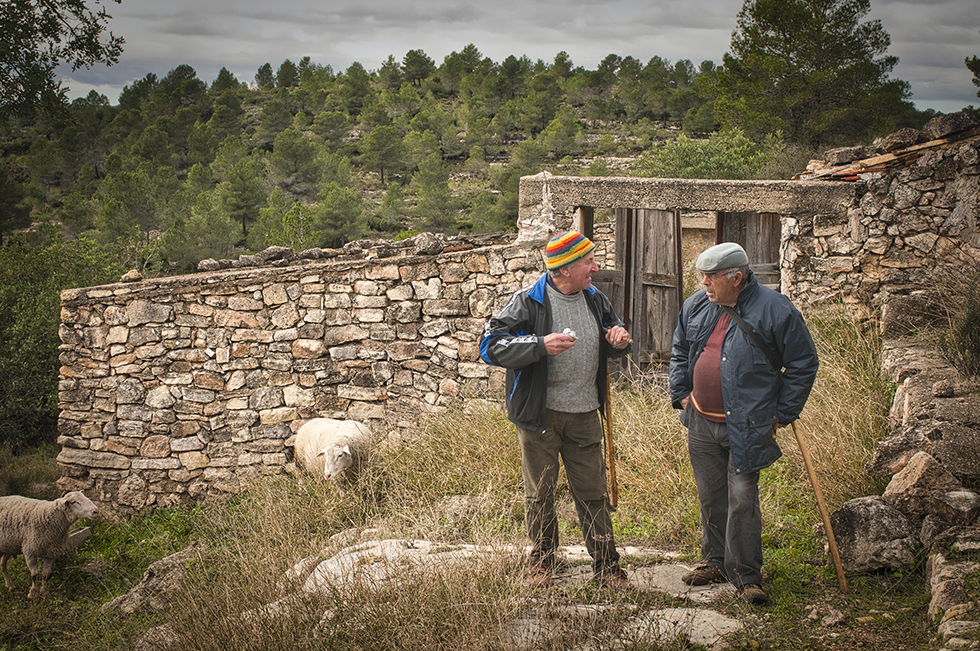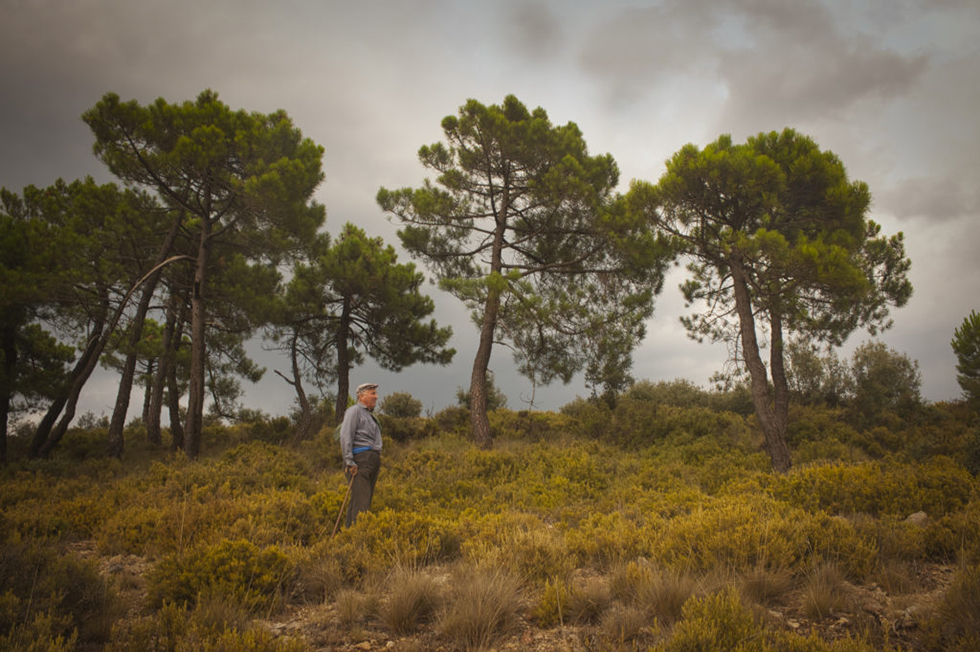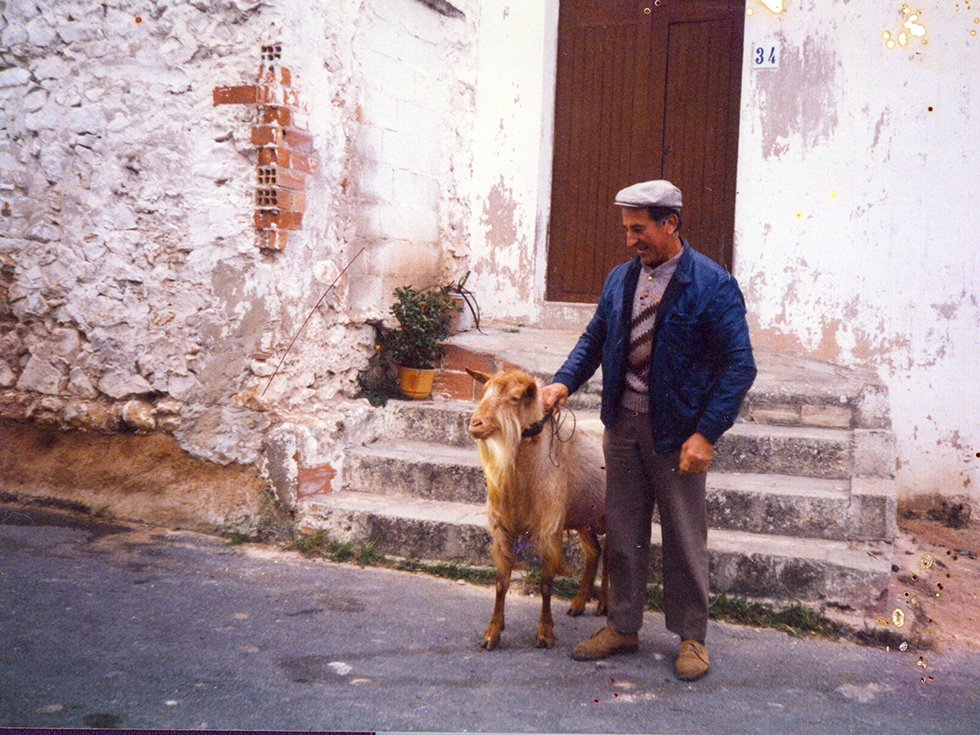Vicente Talens: heritage from a near past

Vicente Talens: heritage from a near past
Text: Xavier Aznar and Jose Mena.
Photography: Jose Mena.
(This article was published on August 2010. Unfortunately, two years later our friend Vicente passed away, leaving us a legacy of incalculable value and an example of honesty, very difficult to find today in this hypocritical society full of rascals).

We are shown, friendly and smiling, a silhouette mounted on the back of an old post-war bicycle, in which the traces of a history full of experiences and fatigue are inserted. Surely few make an adequate reading of what has been and is his presence among us. His image, now archaic, brings us news of a time close in time, but distant in customs. It drives clumsily in the urban core – in what Joaquín Sabina would accurately call “asphalt jungle” -; but, on the contrary, within the rural world she would be able to unravel the deepest secrets of her best friend: nature in its most genuine essence. It would have inspired Miguel Hernández and Buñuel, but instead it would have been mercilessly devoured by the urban neoliberal world. In this elongated silhouette converge, as if by magic, the past and a present that dissolves in our hands, because unfortunately, no sign of permanence is perceived in this figure, and we say “unfortunately” because its history is sign of the loss of a modus vivendi that writes its epilogue before our eyes.

His wisdom, forged by force of blows, is specialized in the most primitive, but effective human improvement in the face of a hostile nature. We are talking about Vicente Talens. Son of a saga of three generations of ancient shepherds who died with him, and with him some customs and a way of understanding and living life. Certainly, and using his image as a sign and symbol, we can speak today of a fall of the world of the field in favor of technical professions that require higher education and that look at the world of their parents as a past to be overcome in favor of a better future than has its praxis in the big cities. Within this context we enclave the article that concerns us. The world of the countryside in Spain and, specifically in our Valencian lands, has been losing slowly but significantly. We can affirm, without fear of being wrong, that we are currently immersed in a “change of era” in a “silent revolution” that had its roots in the emerging market economy. Undoubtedly, the new economic model, based on competition and the social prestige provided by finance, has changed the employment status of our riverside towns. The young man who remained in the town and who continued the work inherited from his parents, and at the time kept the natural garden beautiful and productive, has come to see himself as someone without ambition and, what is worse, without a future. Younger generations have been dazzled by the “neon lights” and siren songs broadcast by social media: too tempting an allure. In this context of economic and social change, we all pass for being notaries of the new historical cycle. Villanueva de Castellón, an eminently rural and agricultural town, has changed its occupational physiognomy and there are now very few who work in the fields and livestock.

Our streets and fields have seen the birth and life of thousands of men and women, and with them, hundreds of traditions and customs. Each one of them has forged the identity of our beloved people; each life – drop of sweat and tears – constitutes our broadest cultural heritage. We carry in our blood the life, struggle and character of thousands of souls who lived under our very sky and who watered our very land with sweat. Today, more than ever, we wish to pay a small tribute, in the figure of a singular man, to all those who sowed our riverside paths with illusions. Let us not forget that no one lives alone, but that each life is the fruit of the weight of the struggle and the history of all those who preceded it. Nature knew how to educate our friend Vicente, since these were not favorable times for teaching in schools, and nature, assuming “its” responsibility, took him in her rough hands and hugged him in her lap. sweat and manure. Tenderly he taught him to have a clean and honest look, while calm and supportive, because pride, arrogance and greed are not children of the countryside.

Observing our friend carefully, you realize that nothing escaped his natural intelligence; It is a knowledge forged in the experience of those who observe life as a gift, with love and respect for themselves and the beauty that surrounds them. It is important to highlight what the prestigious anthropologist Claude Lévi-Strauss affirms regarding this idea. According to the French thinker, we can fall into the error that the type of life of our ancestors and to which we now frivolously say goodbye, lacks technique and deep knowledge of the world. It would be –according to this idea- a knowledge based on pure utilitarianism; that is to say, what is known is done out of necessity and we do not find in him [the country man] any classical or cultural knowledge. The man of the rural world would pass, for today’s world, for being a rough man and lacking in intellectual lights. But -according to Lévi Strauss- an enormous fallacy is hidden in said judgement, because what men educated in nature and in the countryside know, they know through experience, which is the same method used by modern science, so they do not rest on myth but on observation. No technique arises by chance, but by hypothesis repeatedly tested. In this article -as there is room for doubt-, we intend to make visible and tangible, what can go unnoticed by us: make the private public, or -as Turner would say- “make the personal social”. We try to describe a preliminary historical moment; that is, a place in the collective history [of all of us] located between “the one and the other”, as a moment of transition or the beginning of a new conception of work and history. The active subject of a rite of passage, such as the one that concerns us, is invisible to society in the liminal period, so we intend to “make it visible”, so that “this visibility” grants it the cultural value it requires. The curious thing about this case, and therefore remarkable, is that it has a physical reality; that is to say, it is among us, but it does not have a social reality; namely, their modus vivendi has quietly ceased to exist before our eyes. Our commitment as ethnographers is to observe the facts interpretively and not limit ourselves to mere observation. The description, by itself, must be explanatory and interpretive. That must be, and no other, our scientific commitment.

Vicente Talens has had, over a long period of time, the kindness and patience of showing us everything he has learned as an inheritance and his own experience. Without a doubt, he knows that it is time to take stock of a lifetime, and he does so serenely, with the tranquility that his conscience gives him. His childhood forged on the bridle paths, in the loneliness of the walker, with the only company of the harsh winter or summer climate. He was faithfully accompanied by the bleating of his sheep, the company and fidelity of his dog and, of course, the illusion of his own thoughts. Now, retired, with his eyes on the horizon, he manages to understand the importance of the given word and the outstretched hand. In childhood, -he tells us- “the conditions for grazing in the town [Castelló] were very difficult”. He remembers the long periods through herds, roads and fields where he could see life go by [privilege that the shepherd has for his work], while noticing how his life went by.

We have walked with him reliving his memories, specifically along the path he took in summer from Villanueva de Castellón to Alpera, in La Mancha, where it took him two days to reach his destination, crossing places of extraordinary beauty: Sierra del Montot (Cotes ), Sierra de Sumacàrcer, Les Eres (Navarrés), Río Grande (Cañada Real de Almansa), Fuente La Jaraca, Fuente Agujerá, Casa del Alto and Fuente Las Vacas, Caserío Las Madroñas, La Casa del Pino… (Ayora) and Alpera… Vicente gets a lump in his throat, he doesn’t know we’re watching him and his gaze is lost in memory. Suddenly and breaking the uncomfortable silence, he indicates to us the place where he stopped to rest or look for shade, it is easy to imagine him and immerse himself in the clock of his history. From the vantage point of country life, he was able to observe how small and petty the lives of men sometimes became: envy, mistrust, slander…, on the other hand, peace and silence were the privilege and adornment of his life, this allowed him to take a certain distance from things, because time was his ally. In the Sierra de Santa Anna, he picks up some herbs that he now says he needs: the parakeet (Hypericum perforatum) and the gat’s tail (Sideritis tragorinarum). One, suddenly, dreams of a thousand hidden remedies in nature and that, it may be, have been forgotten or veiled in the traffic of the city. This day was a holiday for Vicente, the light has returned to his eyes. Nature has dressed up to receive a friend and does not hide its delights. Vicente carries a bundle of herbs in his fists: it is a corsage, a flowery offering that his mother gives him today: nature; He gives it to us to smell, an enormous happiness is reflected on his face, and of course, we are fascinated by how healthy its aroma is. Some herbs are for the belly, others to cure various infections and others for… well, there is no home remedy that escapes you. The mountain has given him a strong, robust complexion, so that he has always enjoyed extraordinary health, but now, he says, he will not be the same. The song of the papafigues alerts us, we are late and we need to go home, however it gives us time to observe the intense yellow that adorns it perched on the top of a tree. At that same moment we also discover the rossinyol, we approach stealthily and the mother, seeing herself threatened, takes flight vigorously. During the meetings we had with Vicente, he showed us a whole range of healing properties of the mountain and that he applied and applied to himself and his flock. When a sheep appeared with a white eye, what is called a “cloud in the eye” -in Valencian we say “tel”-, means that the animal has been injured or has received a puncture in the bush. You have to act fast: turn it upside down, lock it and grab the ear from the part of the damaged eye; while the tip of the ear is cut, the blood that spurts out is applied directly to the eye and after three days the animal is cured. It doesn’t fail -says Vicente-. When the sheep miscarries or aborts, it is full of milk and is destined to die because “the truss” becomes gangrenous. You try to empty the milk but this is not enough and other measures have to be taken. There is always some sheep that hates one of its young; It is then that a piece of paper is taken and salt is put on it, and, with a cucumber that is introduced into the nature of the female sick by abortion, all of it rubbed by the offspring that has been left aside, makes the sheep believe , for the smell and taste, which is the fruit of her entrails, which saves both: the mother who has lost her calf and the calf who has been despised by her mother. When they miscarried, they had to be given “boiled rue” or “embroidered asparagus” in order to expel the microbes (the pariah or llit). Remember how Aznar [the Ordenari, the town’s carrier that connected the town with the capital of Valencia], brought them the necessary medicines to treat the animals: balsaben and penicillin for milk retention, which took away their fever; you had to give them three punctures, one a day. The balsaben dewormed their livers, and they had to be pricked twice in 15 days. The same operation was repeated twice a year. The tail of the sheep has to be cut when the moon wanes, as the animal has a tendency to catch infections, which he calls “drowsiness[1]”. In addition, the waste of the animals must also be removed when the moon wanes, otherwise the corral would be filled with fleas. With the particularity that it ferments to be used as fertilizer and if it is not removed in this phase of the moon, it dries up.

Vicente recalls that in the town of Villanueva de Castellón there were more than eighteen shepherds and he lists them by name, as if he were listing the sons of Jacob: Salvador, Vicente, Eliseo, Silverio, Fernando, José, – all of them from the saga of the Talens-, Moragues, Fayos, Ramón Aviño[2] [to whom we have already dedicated an article in the past book of festivals], Vicente Alandes, Eusebio Buitrago[3], etc…. It is all because, in Villanueva of Castellón, the rice plantations were good and abundant. The regrowth of the same, once mowed and harvested, was a dish desired by the sheep. From the Escalona ditch downwards, everything was an immense cereal plantation. Once they began to stop planting rice, due to outbreaks of epidemics and other factors, artichokes, melons, white beans and especially orange trees were planted on the highlands due to lack of water. These new plantations did not provide the necessary pastures for the cattle, so the cattle life was ending and with it the shepherds. The new plantations were impregnated with herbicides and cars that became nervous before the obstacle of cattle. He remembers that one day 8 sheep died from eating herbicide, he did not notice that the field had been treated with this material, which caused him great upset. It was possible to be with the five senses, a shepherd could not be clueless, because at the minimum his property was at stake. The same “agret” that grows in the orange groves on the riverbank is tender and juicy for the animal, but with the peculiarity that it hides a thread in the stem that cannot be digested by the sheep. She eats it with a full mouth and can later die of indigestion. Vicente prepared “hot wine” for them and gave it to them so that the food would cook inside their guts and they would not die.

He liked to make cheese, taking advantage of the natural rennet provided by the artichokes. He affirms that it was very good and completely natural, made of suckling lamb. In Castelló he sold it to different shops and it was very well received. He made two varieties: dry and tender. Once the sheep did not give milk, it was time to take it to the slaughterhouse, for which they paid between five thousand and eight hundred pesetas, depending on the moment. So much so that he has known many different prices for animals throughout his life. He has bought sheep in Cárcer for 400 pesetas, when his father used to do it for 40 pesetas, whether they were one, two or three years old. In Navarrés he bought heads of cattle for 1,550 pesetas, he still remembers. Once acquired, it was possible to walk back from Navarrés to Villanueva de Castellón. There he met Ramonazo, with whom he maintains a close friendship. The contract was made verbally and with a handshake, that was enough, today an invoice is made and, even so, people do not get paid, -says Vicente indignantly-. From 7 in the morning, when he left, he would arrive in town at 9 at night, tired but happy. On the way he went alone and sometimes he prayed, he had his beliefs –he says-. He affirms that you have to respect others and be respected at the same time; he has his own ethical code and that he would not betray for anything, a code that he has created in the long hours that the path gave him for reflection. The path was long and the images of the Mare de Déu dels Dolors and that of the Crist dels Prodigis guided their ascetic path towards the fertile banks of the Júcar.

We go back in our imagination to what his hard days at work were like. We imagine that it is summer and it is already dawn, the herd is preparing for the suffocating summer heat. Vicente arrives at the corral and before taking out the impatient sheep, hangs the bag and the crook on the stake of the entrance door. He prepares to carry out his daily liturgy, which consists of separating the lambs born days before from their mothers, since they are still too small to go out into the bush. Then he prepares the rest of the herd for the hard day in the fields of horseshoes and suffocating sun. Finally, the shepherd opens the door and the sheep stampede out. It’s “so many” in the morning. Hours of intense heat awaited him until 11 o’clock, which will be the time when we will return to the corral. We sat in the shade of a huge medlar tree, laden with fruit. Meanwhile, Vicente recounts [we return to the present] how the land is being abandoned more and more because of how poorly paid the farmers are, men who take care of their crops carefully for a time so that the intermediaries take the best part of the cake . “The sheep is raised behind the fence” -he says-, as the plow passes, the grass that comes out is better, has more sap and is newer. The grass of the old and abandoned fields is more “ruin”, for this reason, it is so important that the land is cultivated, working it we all benefit. Why are so many sheep raised in La Mancha? Because the land is worked a lot: stubble fields, fallow land… but not here anymore. Finally, he tells us the anecdote of the snake. It was huge, he says, the dog had been hypnotized by the reptile, and the latter, if not for its quick action, would have suffocated the dog to death. According to Vicente, the snake was so big that it even had a vast hair on its mane. Undoubtedly, the rural world presents us with its own mythology, and has its own “demons” as does the city, since man has an intangible and mysterious dimension.

We end with a reflection of the illustrated poets and Latin classics. We can see how life with the natural environment and with animals has always been surrounded by a certain charm; then it refers to peace and happiness. These are some of the attributes that psychologists now say are missing in our society. Specifically, in the sixth satire of the second book, the Latin poet Horacio describes what for him constitutes the pinnacle of happiness: “Aquests són els meus anhels: un terreny no massa gran, amb un hort al costat, una font d’agua prop of the house and a bosc a la vora”. Horace’s ideal of a retired life, of fleeing from the city, is present when he speaks of “quan jo em vaig retire al meu reducte de la muntanya des de la ciutat”. He goes on to say: “looking at the camps…lo beastar, following the flat life sense brogit, sense passar wins, sense the climatology, exercitant el cos, caçant i collint fruits dels arbres”, seems to correspond to the Horatian ideal or life in the field quan et will I be able to return to veure? How long will it be for me to spend my life in oblivion, both with my free books, or resting and spending the hours? The great Latin poet wonders. The withdrawn and simple life that emerges from these works can be considered as a topic already coming from the Greek and Latin tradition, and that is frequently repeated during the Renaissance, with the examples of Boscá, Garcilaso and the paradigmatic message of Fray Luís de Leo (XXIII, 3-10):
Dichoso el humilde estado
del sabio que se retira
de aqueste mundo malvado,
y con pobre mesa y casa
en el campo deleitoso
con solo Dios se compasa
y a solas su vida pasa,
ni envidiado ni envidioso.

(1) The brain turns to water.
(2) He speaks of him as a brave man. In the middle of winter and with two fingers of frost, he crossed the Albaida River with bare feet, with water up to his calves. Vicente did not dare, because the cold was intense, and, for this, he used plastic boots that he later hid on the banks of the river. Traffic prevented them from crossing the bridge at the top.
(3) Who came from Madrid, after the war, to live in the Villanueva countryside.


